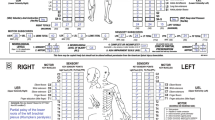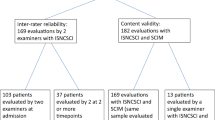Abstract
Study design:
Retrospective cohort study.
Objectives:
To compare the neurological outcome between paraplegic patients with acute spinal cord ischaemia syndrome (ASCIS) or traumatic spinal cord injury (tSCI) and to investigate the influence of SCI aetiology on the total Spinal Cord Independence Measure (SCIM)-II score.
Setting:
Level 1 trauma centre.
Methods:
Initial (0–40 days) and chronic-phase (6–12 months) American Spinal Injury Association (ASIA) sensory scores, lower extremity motor score (LEMS) and chronic-phase total SCIM-II scores were analysed. Differences between ASCIS and tSCI patients were calculated using Student's t-tests and Wilcoxon signed-rank tests. To assess which variables give rise to the prediction of total SCIM-II score, a multiple linear regression analysis was used. These predictor variables included complete (ASIA impairment scale A) or incomplete SCI (AIS B, C, and D), aetiology, age and gender.
Results:
Out of 93 included patients, 20 ASCIS and 73 tSCI patients were identified. In the complete SCI group, the initial pinprick scores were higher (P<0.05) in ASCIS patients compared with tSCI patients, 37.9 (95% Confidence Interval (CI), 23.3–52.5) and 27.3 (95% CI, 24.1–30.4), respectively. No other relevant differences in neurological outcome were identified between ASCIS and tSCI patients; however, the total SCIM-II scores were higher (P<0.05) in tSCI patients after 12 months. Using the linear regression analysis, we were able to predict 31.4% of the variability. The aetiology was not significant in this model.
Conclusion:
The neurological outcome was independent of the diagnosis ASCIS or tSCI. Furthermore, the diagnosis ASCIS or tSCI was not a significant predictor for total SCIM II scores after 12 months.
Sponsorship:
This study was granted by the ’Internationale Stiftung für Forschung in Paraplegie‘ (IFP), Zürich, Switzerland.
Similar content being viewed by others
Log in or create a free account to read this content
Gain free access to this article, as well as selected content from this journal and more on nature.com
or
References
Sandson TA, Friedman JH . Spinal cord infarction. Report of 8 cases and review of the literature. Medicine (Baltimore) 1989; 68: 282–292.
Cheshire WP, Santos CC, Massey EW, Howard Jr JF . Spinal cord infarction: etiology and outcome. Neurology 1996; 47: 321–330.
Masson C, Pruvo JP, Meder JF, Cordonnier C, Touzé E, De La Sayette V et al. Spinal cord infarction: clinical and magnetic resonance imaging findings and short term outcome. J Neurol Neurosurg Psychiatry 2004; 75: 1431–1435.
Nedeltchev K, Loher TJ, Stepper F, Arnold M, Schroth G, Mattle HP et al. Long-term outcome of acute spinal cord ischemia syndrome. Stroke 2004; 35: 560–565.
Iseli E, Cavigelli A, Dietz V, Curt A . Prognosis and recovery in ischaemic and traumatic spinal cord injury: clinical and electrophysiological evaluation. J Neurol Neurosurg Psychiatry 1999; 67: 567–571.
Bracken MB, Shepard MJ, Holford TR, Leo-Summers L, Aldrich EF, Fazl M et al. Administration of methylprednisolone for 24 or 48 hours or tirilazad mesylate for 48 h in the treatment of acute spinal cord injury. Results of the third national acute spinal cord injury randomized controlled trial. National Acute Spinal Cord Injury Study. JAMA 1997; 277: 1597–1604.
Papadopoulos SM, Selden NR, Quint DJ, Patel N, Gillespie B, Grube S . Immediate spinal cord decompression for cervical spinal cord injury: feasibility and outcome. J Trauma 2002; 52: 323–332.
Steeves JD, Lammertse D, Curt A, Fawcett JW, Tuszynski MH, Ditunno JF et al. Guidelines for the conduct of clinical trials for spinal cord injury (SCI) as developed by the ICCP panel: clinical trial outcome measures. Spinal Cord 2007; 45: 206–221.
Wirz M, Zorner B, Rupp R, Dietz V . Outcome after incomplete spinal cord injury: central cord versus Brown-Sequard syndrome. Spinal Cord 2010; 48: 407–414.
Elksnis SM, Hogg JP, Cunningham ME . MR imaging of spontaneous spinal cord infarction. J Comput Assist Tomogr 1991; 15: 228–232.
Neumann S, Woolf CJ . Regeneration of dorsal column fibers into and beyond the lesion site following adult spinal cord injury. Neuron 1999; 23: 83–91.
Maynard Jr FM, Bracken MB, Creasey G, Ditunno Jr JF, Donovan WH, Ducker TB et al. International standards for neurological and functional classification of spinal cord injury. American Spinal Injury Association. Spinal Cord 1997; 35: 266–274.
Itzkovich M, Tripolski M, Zeilig G, Ring H, Rosentul N, Ronen J et al. Rasch analysis of the Catz-Itzkovich spinal cord independence measure. Spinal Cord 2002; 40: 396–407.
Catz A, Itzkovich M, Steinberg F, Philo O, Ring H, Ronen J et al. The Catz-Itzkovich SCIM: a revised version of the Spinal Cord Independence Measure. Disabil Rehabil 2001; 23: 263–268.
McKinley WO, Seel RT, Hardman JT . Nontraumatic spinal cord injury: incidence, epidemiology, and functional outcome. Arch Phys Med Rehabil 1999; 80: 619–623.
Furlan JC, Fehlings MG . The impact of age on mortality, impairment, and disability among adults with acute traumatic spinal cord injury. J Neurotrauma 2009; 26: 1707–1717.
Scivoletto G, Morganti B, Molinari M . Neurologic recovery of spinal cord injury patients in Italy. Arch Phys Med Rehabil 2004; 85: 485–489.
Catz A, Goldin D, Fishel B, Ronen J, Bluvshtein V, Gelernter I . Recovery of neurologic function following nontraumatic spinal cord lesions in Israel. Spine (Philadelphia, PA, 1976) 2004; 29: 2278–2282.
Salvador de la BS, Barca-Buyo A, Montoto-Marques A, Ferreiro-Velasco ME, Cidoncha-Dans M, Rodriguez-Sotillo A . Spinal cord infarction: prognosis and recovery in a series of 36 patients. Spinal Cord 2001; 39: 520–525.
Daverat P, Petit H, Kemoun G, Dartigues JF, Barat M . The long term outcome in 149 patients with spinal cord injury. Paraplegia 1995; 33: 665–668.
Author information
Authors and Affiliations
Corresponding author
Ethics declarations
Competing interests
The authors declare no conflict of interest.
Rights and permissions
About this article
Cite this article
Pouw, M., Hosman, A., van Kampen, A. et al. Is the outcome in acute spinal cord ischaemia different from that in traumatic spinal cord injury? A cross-sectional analysis of the neurological and functional outcome in a cohort of 93 paraplegics. Spinal Cord 49, 307–312 (2011). https://doi.org/10.1038/sc.2010.114
Received:
Revised:
Accepted:
Published:
Issue date:
DOI: https://doi.org/10.1038/sc.2010.114
Keywords
This article is cited by
-
Early clinical predictors of functional recovery following traumatic spinal cord injury: a population-based study of 143 patients
Acta Neurochirurgica (2021)
-
Impact of Heat Shock Protein A 12B Overexpression on Spinal Astrocyte Survival Against Oxygen-Glucose-Serum Deprivation/Restoration in Primary Cultured Astrocytes
Journal of Molecular Neuroscience (2016)
-
Survival following spinal cord infarction
Spinal Cord (2013)
-
Recovery following ischemic myelopathies and traumatic spinal cord lesions
Spinal Cord (2011)
-
Is the outcome in acute spinal cord ischaemia different from that in traumatic spinal cord injury? A cross-sectional analysis of the neurological and functional outcome in a cohort of 93 paraplegics
Spinal Cord (2011)



